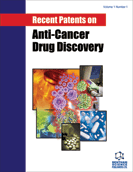
Abstract
Inhibitors of immune check-point molecule, programmed cell death 1 (PD-1) and its ligand, programmed cell death ligand 1 (PD-L1) have attracted much attention in cancer immunotherapy recently due to their durable antitumor effects in various malignances, especially the advanced ones. Unfortunately, only a fraction of patients with advanced tumors could benefit from anti-PD-1/PD-L1 therapy, while others still worsened. The key to this point is that there are no efficient biomarkers for screening anti-PD-1/PD-L1-sensitive patients. In this review, we aim at summarizing the latest advances of anti-PD-1/PDL1 immunotherapy and the potential predictive efficacy biomarkers to provide evidences for identifying anti-PD-1/PDL1- sensitive patients. The present article also includes the patent review coverage on this topic.
Keywords: Efficacy, immune check-point, immunotherapy, monoclonal antibodies, predictive efficacy biomarkers, programmed cell death 1, programmed cell death 1 ligand.
Recent Patents on Anti-Cancer Drug Discovery
Title:Predictive Efficacy Biomarkers of Programmed Cell Death 1/Programmed Cell Death 1 Ligand Blockade Therapy
Volume: 11 Issue: 2
Author(s): Xiao-Na Fang and Li-Wu Fu
Affiliation:
Keywords: Efficacy, immune check-point, immunotherapy, monoclonal antibodies, predictive efficacy biomarkers, programmed cell death 1, programmed cell death 1 ligand.
Abstract: Inhibitors of immune check-point molecule, programmed cell death 1 (PD-1) and its ligand, programmed cell death ligand 1 (PD-L1) have attracted much attention in cancer immunotherapy recently due to their durable antitumor effects in various malignances, especially the advanced ones. Unfortunately, only a fraction of patients with advanced tumors could benefit from anti-PD-1/PD-L1 therapy, while others still worsened. The key to this point is that there are no efficient biomarkers for screening anti-PD-1/PD-L1-sensitive patients. In this review, we aim at summarizing the latest advances of anti-PD-1/PDL1 immunotherapy and the potential predictive efficacy biomarkers to provide evidences for identifying anti-PD-1/PDL1- sensitive patients. The present article also includes the patent review coverage on this topic.
Export Options
About this article
Cite this article as:
Fang Xiao-Na and Fu Li-Wu, Predictive Efficacy Biomarkers of Programmed Cell Death 1/Programmed Cell Death 1 Ligand Blockade Therapy, Recent Patents on Anti-Cancer Drug Discovery 2016; 11 (2) . https://dx.doi.org/10.2174/1574892811666160226150506
| DOI https://dx.doi.org/10.2174/1574892811666160226150506 |
Print ISSN 1574-8928 |
| Publisher Name Bentham Science Publisher |
Online ISSN 2212-3970 |
 116
116 3
3 1
1 1
1
- Author Guidelines
- Graphical Abstracts
- Fabricating and Stating False Information
- Research Misconduct
- Post Publication Discussions and Corrections
- Publishing Ethics and Rectitude
- Increase Visibility of Your Article
- Archiving Policies
- Peer Review Workflow
- Order Your Article Before Print
- Promote Your Article
- Manuscript Transfer Facility
- Editorial Policies
- Allegations from Whistleblowers
Related Articles
-
Prognostic Role of Hedgehog-GLI1 Signaling Pathway in Aggressive and Metastatic Breast Cancers
Current Drug Metabolism Ivermectin Inhibits Bladder Cancer Cell Growth and Induces Oxidative Stress and DNA Damage
Anti-Cancer Agents in Medicinal Chemistry Therapeutic Applications of Curcumin and its Novel Formulations in the Treatment of Bladder Cancer: A Review of Current Evidence
Anti-Cancer Agents in Medicinal Chemistry Infection and Malignancy Risk in Patients Treated with TNF Inhibitors for Immune-Mediated Inflammatory Diseases
Current Drug Safety Vitamin C as an Anticancer Agent: Regulation of Signaling Pathways
Current Topics in Medicinal Chemistry Radiolabeled Peptide Probes for Liver Cancer Imaging
Current Medicinal Chemistry Phenolic Compounds in Prevention and Treatment of Skin Cancers: A Review
Current Medicinal Chemistry Myeloperoxidase as a Target for the Treatment of Inflammatory Syndromes: Mechanisms and Structure Activity Relationships of Inhibitors
Current Medicinal Chemistry Development of a Radiolabeled Amlodipine Analog for L-type Calcium Channel Imaging
Current Radiopharmaceuticals Diastereoselective Synthesis of Dispiropseudoindoxyls and Preparation of 9-Oxopyrrolo[ 1,2-α]Indoles
Current Organic Synthesis Cancer Stem Cell Model in Oral Squamous Cell Carcinoma
Current Stem Cell Research & Therapy Inhibition of EGFR Signaling by N-cyclohexyl-2-(1-(phenylsulfonyl)piperidin-4-yl) acetamide
Anti-Cancer Agents in Medicinal Chemistry Biology of Cox-2: An Application in Cancer Therapeutics
Current Drug Targets Immune Response to Herpes Simplex Virus and γ134.5 Deleted HSV Vectors
Current Gene Therapy CD47 Functionalization of Nanoparticles as a Poly(ethylene glycol) Alternative: A Novel Approach to Improve Drug Delivery
Current Drug Targets Aminolevulinic Acid Derivatives and Liposome Delivery as Strategies for Improving 5-Aminolevulinic Acid- Mediated Photodynamic Therapy
Current Medicinal Chemistry Cellular Functions of RNA-Binding Motif Protein 3 (RBM3): Clues in Hypothermia, Cancer Biology and Apoptosis
Protein & Peptide Letters Cancer Stem Cell Markers in Nasopharyngeal Carcinoma and Its Relevance for Therapy
Current Traditional Medicine Vasotrophic Regulation of Age-Dependent Hypoxic Cerebrovascular Remodeling
Current Vascular Pharmacology Synthesis, Biological Evaluation and Molecular Dynamics Simulation Studies of Novel Diphenyl Ethers
Medicinal Chemistry


























